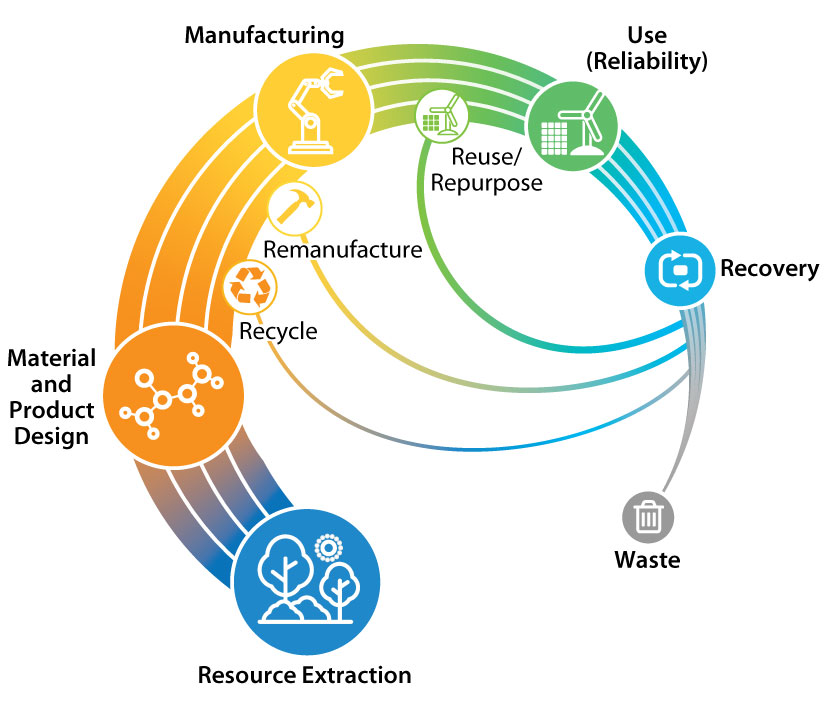Battery Recycling Supply Chain Analysis
NREL's lithium-ion (Li-ion) battery recycling supply chain research guides decision-makers at the forefront of the clean energy transition with detailed assessments, benchmarking, and analyses to identify gaps and ensure manufacturing resiliency.
 Featured Tool
Featured Tool
Electrification of the transportation and energy storage markets will result in explosive growth in the demand for Li-ion batteries. However, raw materials used in these batteries—such as cobalt, nickel, and lithium—are not domestically produced or refined in sufficient quantities to meet today or tomorrow's battery demand. Li-ion battery recycling is crucial to enable supply chain resilience in the U.S and globally.
The intersection of different markets, operations, and policies will impact global electrification efforts. To understand more about this challenge, NREL researchers developed the LIBRA: Lithium-Ion Battery Resource Assessment Model.
Key Impacts
Over the past few years, NREL's analysis experts have been instrumental in understanding how the growing electric vehicle (EV) market will impact the Li-ion battery recycling supply chain. NREL's research has informed numerous projects and policies that lay the groundwork for the battery recycling infrastructure of the future, including the U.S. Department of Energy's National Blueprint for Lithium Batteries.


(Left) Early LIBRA analysis evaluated the total U.S. annual Li-ion battery sales by battery factor to emphasize the scope of impact EV sales will have on the market. (Right) LIBRA estimated how the distribution of battery chemistries used in Li-ion batteries would evolve over time to show how recycling might change over time.
NREL researchers continue to track the global flow of different critical materials used in today's EVs. This data, mapped for cobalt in the graphic below, illustrates the movement of different materials throughout the Li-ion battery supply chain, from mineral extraction to EV application. This emphasizes how Li-ion battery recycling would help bridge a critical gap in domestic access to battery materials.

*Mining, Recycling, and Preprocessing products includes ores, naturally occurring solids containing cobalt, and mattes and intermediates (30–100% cobalt).
Circular Economy Characterization
NREL's battery recycling supply chain analysis allows researchers to evaluate the evolution of the battery markets from both supply and demand perspectives. The model characterizes the entire circular economy for Li-ion batteries, including:

- Cost of resources, e.g., supply and demand of raw materials
- Changes in battery chemistry
- Design for circular economy
- Battery lifetime and market size
- Collection and transportation of batteries at the end of their useful lives
- Battery second-life market
- Manufacturing scrap recycling
- Direct recycling and remanufacturing
- Pyrometallurgical and hydrometallurgical recycling
- Safe disposal.
Featured Projects
NREL researchers recently used LIBRA to estimate how recycling scrap material from consumer battery and cathode manufacturing would impact the raw material supply for new manufacturing. Manufacturing scrap materials will dominate the Li-ion battery waste stream until 2040 when end-of-life batteries from EVs become available for recycling, kick-starting the recycling industry and closing the materials gap for manufacturing.
This analysis demonstrates that manufacturing scrap and end-of-life batteries can be a substantial source of raw materials for domestic manufacturing, offering greater supply chain resiliency for U.S. battery manufacturers.NREL researchers used LIBRA to evaluate the impact and importance of battery chemistry and sorting in the recycling supply chain. Commercially available Li-ion batteries include a range of different chemistries, and these findings show that automated sorting can help recyclers selectively process batteries based on the material makeup.
In this study, LIBRA emphasized how automated sorting will be particularly impactful for cobalt recovery before 2035, before low-cobalt battery designs become more popular in the marketplace. At $23 per pound for cobalt in 2021, targeting high-cobalt chemistries can help incentive investments by making Li-ion battery recycling more profitable.
Featured Articles
Publications
Impact of Automated Battery Sorting for Mineral Recovery from Lithium-Ion Battery Recycling in the United States, Resources, Conservation and Recycling (2023)
Battery Energy Storage Scenario Analyses Using the Lithium-Ion Battery Resource Assessment (LIBRA) Model, NREL Technical Report (2023)
Economics and Challenges of Li-Ion Battery Recycling from End-of-Life Vehicles, Procedia Manufacturing (2019)
The Case for Recycling: Overview and Challenges in the Material Supply Chain for Automotive Li-ion Batteries, Sustainable Materials and Technologies (2019)
Contact
Margaret (Maggie) Mann
Lead, Clean Energy Supply Chain and EV Storage Analysis
Margaret.Mann@nrel.gov303-275-2921
Share



